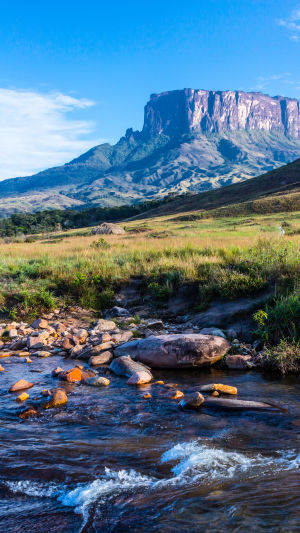Canaima National Park in Venezuela covers an area of 30,000 square kilometers and protects a portion of the Guayana Highlands moist forest eco-region.
The park is home to the renowned tepuis, including the world's highest waterfall, Angel Falls. In 1994, Canaima National Park was designated as a UNESCO World Heritage Site for its unique landscapes.
<h3>Distinctive Landscape of Tepui Mountains</h3>
Canaima National Park is Venezuela's second-largest park, following only the Parima-Tapirapecó National Park.
Approximately 65% of the park is occupied by the tepuis, tabletop mountains that have been sculpted over billions of years. At the center of the park, there is a tabletop mountain peak with vertical cliffs and nearly flat summits, known geologically as a mesa. Surrounding it are other plateau mountains with similar structures.
The unique geological formation of the Tepui Mountains makes it a significant biogeographical region with profound geological and ecological importance. The geological structures in this area date back between 1.5 to 2 billion years, representing some of the oldest formations on Earth.
The rock formations atop the mountain base consist of ancient sandstones overlaying even older granitic rocks, with a history spanning nearly 3 billion years.
The carving action of rivers has formed canyons and waterfalls, creating a unique geological landscape and ecological environment. Within the park are the Caroní River watershed and the world's highest waterfalls—Angel Falls and Kukenán Falls—as well as numerous lower-latitude waterfalls.
The park boasts over 300 species of endemic plants, including a rich diversity of carnivorous plants. At the summit of the Tepui Mountains, there is a particular plant community that preys on insects. These plants attract insects with the scent of their flowers, which are brightly colored.
Once trapped, the insects are digested by the plants, earning them the name "carnivorous plants." The unique food chains and carnivorous plant habitats in the area have attracted significant interest from biologists.
<h3>Moist Forest Eco-region of Guayana Highlands</h3>
The Guayana Highlands moist forest is part of the Amazon biome. This region consists of plateaus and Amazonian swamps, historically inaccessible to humans, and largely pristine, remaining in a wilderness state, making it one of 200 moist forest eco-regions globally.
Most of the eco-region lies at elevations between 500 to 1500 meters, with rugged terrain. The Guayana Highlands eco-region forms an elevated "island" within the Amazon biome, with its highest point being Mount Roraima at 3000 meters above sea level. The surrounding areas are characterized by grasslands and forests. Records indicate the presence of 209 mammal species, including jaguars and pumas, as well as 631 bird species and a plethora of reptiles and amphibians.
<h3>World's Highest Angel Falls</h3>
Angel Falls, situated in the southeastern Guayana Highlands of Venezuela, is part of Canaima National Park.
It is one of the most spectacular waterfalls globally and holds the title of the world's highest waterfall, with a total drop of 979 meters. Originating from the edge of the tepuis in Canaima National Park, the waterfall descends over a rocky slope of about 400 meters, forming a cascade rather than plunging into a deep pool like conventional waterfalls.
As we reflect on the splendor of Canaima National Park, let us remember the importance of preserving and protecting these natural treasures for future generations to cherish and enjoy. May the awe-inspiring landscapes and ecological wonders of Canaima continue to inspire awe and reverence for the incredible beauty of our planet Earth.





